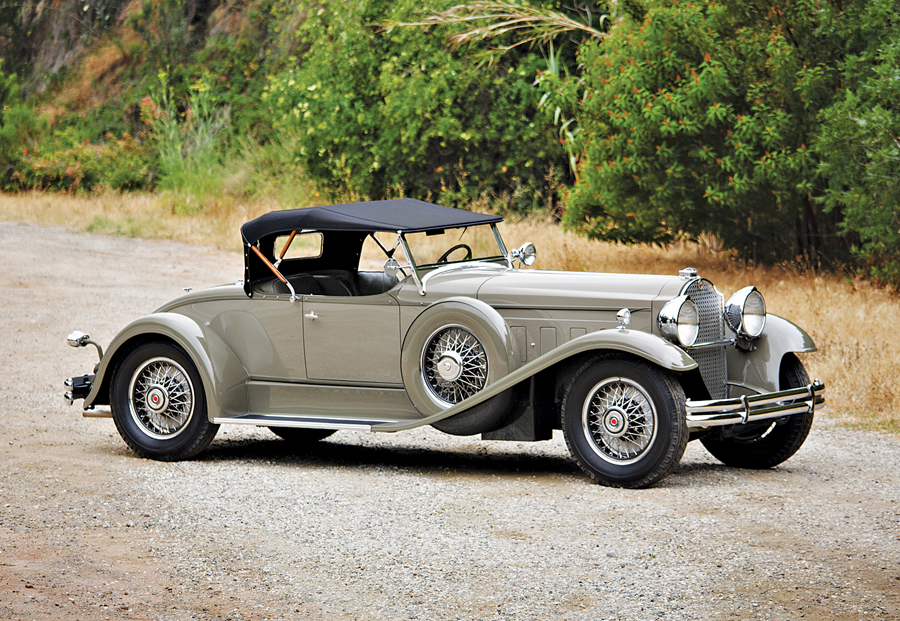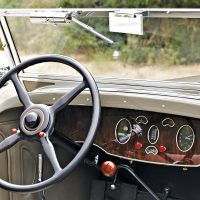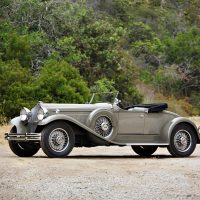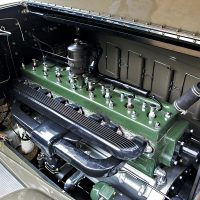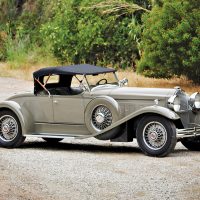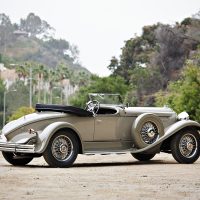In 1930, as Detroit was in the middle of an escalating horsepower race, Packard unveiled the 734 Speedster — an understated high-performance model that is perhaps the finest sporting machine built by an American manufacturer during the Classic Era.
Despite its limited production, the 734 Speedster was offered in five distinct body styles: runabout, phaeton, Victoria, sedan and roadster.
Custom tailored to the dimensions of the high-performance chassis, the Speedster’s body was built in Packard’s own coachworks, where standard bodies were narrowed, sectioned and trimmed to more striking proportions.
While most body styles were conservative, the 2-passenger runabout, with its exotic boattail, minimal top and dramatic staggered seating arrangement, was overtly sporting.
When new, these exclusive cars commanded a list price of more than $5,000 — at a time when a new Ford Roadster cost just $460. The Model 734 Speedster presented here is among the finest in existence and one of the few whose history can be traced back to new.
SCM Analysis
Detailing
| Vehicle: | 1930 Packard 734 Speedster Runabout |
| Years Produced: | 1930 |
| Number Produced: | 113 |
| Original List Price: | $5,200–$6,000 |
| SCM Valuation: | Median to date, $180,000; high sale, $2,090,000 (this car) |
| Tune Up Cost: | $650 |
| Distributor Caps: | $450 |
| Chassis Number Location: | Metal firewall plate |
| Engine Number Location: | Boss on upper left corner of block |
| Club Info: | Classic Car Club of America |
| Website: | http://classiccarclub.org |
| Alternatives: | 1930 Duesenberg Model J Murphy convertible coupe, 1935 Auburn 851SC Boattail Speedster, 1930 Cadillac V16 convertible |
| Investment Grade: | A |
This car, Lot 30, sold for $2,090,000, including buyer’s premium, at Gooding’s annual sale in Pebble Beach, CA, on August 19, 2016.
The 734 Speedster was the finest automobile produced by Packard. The company then promptly parked it on the back row, hoping it would go away.
A sporting Packard
The 734 Speedster was developed by Jesse Vincent, Packard’s head of engineering. Vincent based the new car on the experimental 626 Packard Speedster of 1929.
Initially, Vincent was given free reign over the design of the car, and with that he placed a highly modified Deluxe straight-eight engine into a shortened Standard Eight chassis. The highly tuned 385-ci straight-eight motor produced 145 horsepower — a figure only exceeded by the Duesenberg Model J’s massive eight.
The car was about three inches narrower and considerably lower than the standard Seventh Series Packard. The windshield did not fold down and the cowl was lengthened about five inches. All the bodies were built in the Packard custom body shops and carried “Custom made by Packard” badges. The Runabout had a unique seating arrangement with the passenger’s seat staggered, or set back, from the driver’s seat.
A change of direction
Ultimately, the Speedster was born into a perfect storm that led to its demise.
Alvan Macauley, president of Packard, didn’t see eye to eye with Vincent on the Speedster project, and he attempted to kill it. But since the car was already in production, the Speedster continued on, only with lackluster support. Highlighting this was the fact that while Packard was known for luxurious brochures, they only produced a one-color, eight-page piece for the Speedster that had renderings of the four body styles available — the Roadster was introduced later in the year, with only two produced. Packard did not even present it at the January New York Auto Show — an event designed for such significant automobile introductions.
The stock market crashed as Cadillac introduced its V16, and Packard as a company then questioned the wisdom of a prestige car manufacturer producing a sporty hot rod.
Attention was diverted to the V12 and the possibility of a front-wheel-drive offering. The Speedster disappeared with the introduction of the Eighth Series for 1931, and no one seemed to notice.
Today, however, the cars are sought after by collectors, and when good examples come to auction, they tend to bring high prices across the auction block.
Lineage, condition and price
The 734 Packard Speedster Runabout offered by Gooding was a spectacular example well known in the Pacific Northwest.
Glenn Mounger, the former chairman of the Pebble Beach Concours d’Elegance, acquired it in 1985. Before that, the car had been in the Cravens Collection in Canada and wore maroon and silver livery. It had impeccable lineage back to the time it was first delivered to David Williams in Tulsa, OK, in 1930. The car had never been altered or abused.
Mounger sold the car to a good friend but was able to reacquire it in 2000. He then gave the car a comprehensive restoration, returning it to its original Plymouth and Pilgrim Gray with Ivory Drop Black moldings and French Gray pinstripe. The result was stunning and the restoration, performed over 15 years ago, is still concours-worthy today.
The car sold for well over the Gooding high estimate of $1,500,000 and well above the $975,000 previous high sale noted in the SCM Platinum Auction Database (SCM# 4823989). But at $2,090,000, was this an example of auction fever or did the buyer make an astute decision?
This is a Full Classic that will stand the test of time, as illustrated by the fact that three of the final bidders were under 50 years of age. While not a bargain, I would certainly call it wisely bought as one of the rarest and most sought-after Packards ever built. ♦
(Introductory description courtesy of Gooding & Company.)
